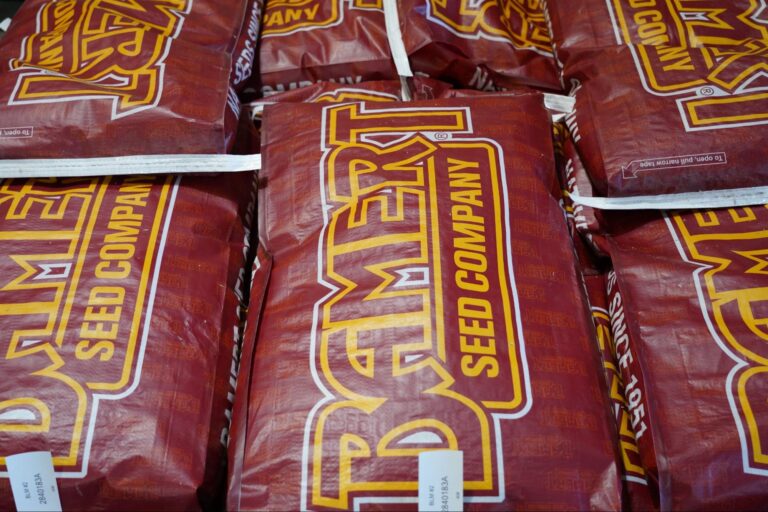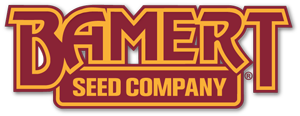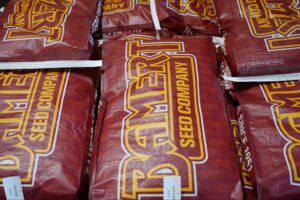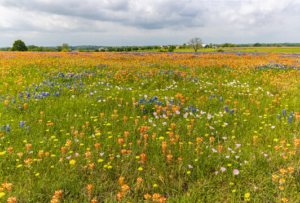Choosing the right native seed mix for your project isn’t just a line item — it’s critical to long-term success.
Whether you’re managing solar reclamation, an oil and gas site, or another large-scale infrastructure project, knowing these five answers could save you time, money, and headaches.

1. How long does it take native seed to establish?
Myth: It takes 3 years for native seed to establish.
Fact: With the correct native seed mix it can be much faster.
Native grasses aren’t like turfgrass or cover crops. They take time to build resilience. We tell our clients to think in seasons, not weeks. The typical establishment period for native seed follows this pattern:
- Phase 1: It sleeps. You’ll see some green, but below the surface, roots are building.
- Phase 2: It creeps. Growth improves, and early species fill in.
- Phase 3: It leaps. The mix matures, and your site starts functioning like a native ecosystem.
In the end, you get reduced erosion, lower inputs, and long-term success.
2. Will native seed work in my area?
Myth: Natives won’t survive in my region — it’s too dry/windy/sandy/etc.
Fact: The correct natives won’t just survive, they’ll thrive.
We hear this one a lot — especially in regions with harsh soils, extreme weather, or heavy site pressure.
The truth? Native species evolved for your conditions. The key is selecting the right ones.
That’s where custom blends and seed specifications come in. Our team works with solar developers, oil & gas clients, and DOT contractors across the country to match species & varieties to soil type, rainfall, and reclamation goals. And we don’t just take your spec and fill it — we evaluate it and make recommendations where needed.
3. What is PLS, and why does it matter?
Myth: I’m getting a better deal buying seed by the pound.
Fact: Only PLS (Pure Live Seed) tells you how much viable seed you’re actually planting. Bulk pounds can be full of non-viable filler.
If you’re comparing prices, make sure you’re comparing PLS rates, not just bulk weight. Bulk bags can contain stems, empty hulls, or dormant seed. PLS ensures you’re paying for viable, tested seed—no filler.
Need a refresher? We break it all down here: PLS vs. Bulk Explained
4. Do you sell in bulk?
Myth: Any seed company can fill a large order.
Fact: At Bamert, we’re built for it.
With our own production fields, large-scale cleaning equipment, and a professional team that understands the demands of big projects, we’re ready to deliver — and fast.
Whether it’s hundreds of pounds for a utility-scale solar reclamation project or a blend for a pipeline corridor, we specialize in large native seed mixes.
Before sending a quote, we double-check your spec. If we see red flags — wrong species, poor fit for your soil type — we’ll let you know. That’s just part of the service.
Because with big projects, there’s no room for guesswork.
Need a quote? Here’s how veteran seed project managers do it:
“Hi, I need a quote. I’m in [Specific Region of State], doing a [Project Type], and here’s our spec.”
Yes, it’s that easy.
5. How do I read a seed tag?
Myth: A seed tag is just for warehouse tracking.
Fact: The seed tag holds essential compliance and quality data — like germination rate and test date — that impact your project’s success.
You’ll find:
- Species and variety
- Germination %
- Purity %
- PLS rate
- Test date
Need help interpreting yours? Check out our guide: How to Read a Seed Bag Tag
Bonus: Want to build a better spec?
We created Seed-Spec to make spec writing faster and more accurate. It’s free, easy to use, and backed by expert recommendations.
👉 Try it here: https://seedspec.com/
Need help choosing a native seed mix?
We’ve helped thousands of project managers across industries get the right seed for long-term results. Let us do the same for you.
🟢 Request a quote now or call 1-806-639-5232 to talk to a native seed expert.



